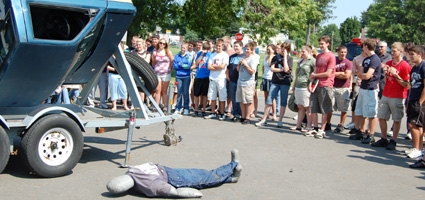Norwich students learn important lessons at Driver's Ed
NORWICH – While teen drivers only account for a fraction of the total miles driven in the United States each year, they make up a disproportionately high percentage of accident fatalities.
“Don’t let that be you,” said Trooper Richard Siefert, a 24-year veteran of the New York State Police, as he addressed the 81 Norwich High School students enrolled in the school’s 6-week driver’s education program.
According to the long-time law enforcement officer, if teenagers would just buckle up, slow down and stay off their cell phones while driving, they would not only reduce their chance of having an accident, but increase their chances of surviving one as well.
New York State Trooper Peter Grunder, who serves as the school and community outreach coordinator for Troop C, accompanied Siefert to Norwich High School. Together they gave a two-part presentation on the importance of wearing a seat belt and factors which contribute to motor vehicle accidents, particularly among teens.
Using a specially designed simulator, the state police officers demonstrated what happens to passengers who are not properly belted in when a vehicle is involved in a rollover accident at 25 miles an hour.
“Rollovers account for a tenth of all accidents, but one fifth of fatalities,” Grunder explained. This point was driven home to students when, on one of the first revolutions, the toddler-sized crash dummy which had been unrestrained in the passenger compartment of the simulator was thrown from the vehicle.











Comments